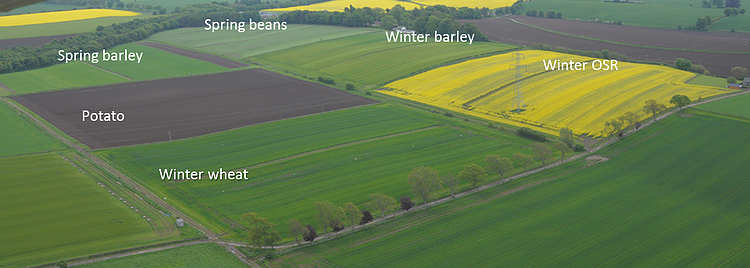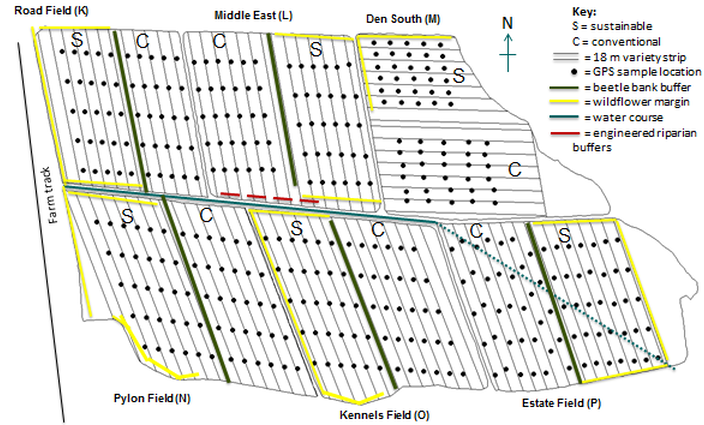Design
The Centre for Sustainable Cropping comprises a 42 hectare block of six fields in the
south-east of Balruddery Farm.
The effects of the integrated cropping systems are tested relative to standard commercial
practice using a split-field design over multiple six year rotations.
 Ariel view of CSC site at Balruddery
Ariel view of CSC site at Balruddery
Each half field (assigned to either conventional or integrated management) is planted with
two crop varieties to test varietal response to change in management.
An additional 18 m strip along each edge of each half field is available for plot-scale
experiments.
Across the whole site there are a total of 360 permanent GPS locations at which key arable
systems indicators are monitored throughout each growing season.

Site maps are available to download in PDF format for:
2016/17,
2015/16,
2014/15,
2013/14,
2012/13 and
2011/12.
Crops
Crop rotation:
- potato
- winter wheat
- winter barley
- winter oilseed
- field beans
- spring barley
Although not a typical rotation, these crops were selected to ensure relevance of our
results to industry by including the most commonly grown crops in the Tayside region and
those that form the basis of much of the crop research at the JHI.
In the baseline years 2009 and 2010, all 6 fields were sown with maize to even out some of
the within-field variation due to previous cropping histories and to provide a C4 input to
the soil for an initial measure of carbon turnover.
CSC Platform Cropping History
|
Road |
Middle East |
Den South |
Estate |
Kennels |
Pylon |
| 2011 | Pot | SB | Bea | WW | WOS | WB |
| 2012 | WW | Pot | SB | Bea | WB | WOS |
| 2013 | WOS | WW | Pot | SB | Bea | WB |
| 2014 | SB | Bea | WW | Pot | WB | WOS |
| 2015 | WOS | SB | Bea | WW | Pot | WB |
| 2016 | WB | WOS | SB | Bea | WW | Pot |
| 2017 | Pot | SB | Bea | WOS | WB | WW |
| 2018 | WW | Pot | SB | Bea | WOS | WB |
| 2019 | WB | WW | Pot | SB | Bea | WOS |
| 2020 | Rotation continues as of 2017 onwards… |
In the first rotation (2010/11 to 2016), 5 different cultivars of each crop were sown in
18m wide strips in each half field to assess differences in cultivar response to the reduced
input system.
In the second rotation (2016/17 to 2022), 2-3 cultivars are compared over larger blocks in
each half field to allow more commercially realistic crop management and better assessment
of the spatial variation across the fields.
Crop varieties are selected to include one industry standard to compare against varieties
with a range of environmental traits – resource use efficiency, weed suppression, disease
resistance etc.
Click here to download an Excel sheet containing the lists of cultivars tested


 Ariel view of CSC site at Balruddery
Ariel view of CSC site at Balruddery